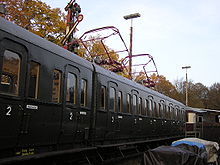
The S-Bahn is a hybrid urban-suburban rail system serving a metropolitan region predominantly in German-speaking countries. Some of the larger S-Bahn systems provide service similar to rapid transit systems, while smaller ones often resemble commuter or even regional rail systems. The name S-Bahn derives from Schnellbahn, Stadtbahn or Stadtschnellbahn.
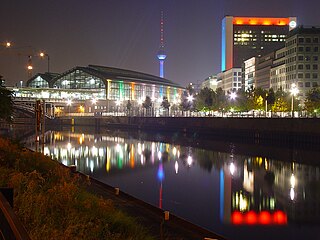
The Berlin S-Bahn is a rapid transit railway system in and around Berlin, the capital city of Germany. It has been in operation under this name since December 1930, having been previously called the special tariff area Berliner Stadt-, Ring- und Vorortbahnen. It complements the Berlin U-Bahn and is the link to many outer-Berlin areas, such as Berlin Brandenburg Airport. As such, the Berlin S-Bahn blends elements of a commuter rail service and a rapid transit system.

The Hamburg S-Bahn is a suburban commuter railway network in the Hamburg Metropolitan Region. Together, the S-Bahn, the Hamburg U-Bahn, the AKN railway and the regional railway form the backbone of railway public transport in the city and the surrounding area. The network has operated since 1907 as a commuter rail system, under the direction of the state railway, and is a member of the Hamburger Verkehrsverbund. There are six lines, serving 68 stations, on 147 kilometres (91 mi) of route. On an average working day the S-Bahn transports about 590,000 passengers; in 2010 about 221 million people used the S-Bahn.

The Hamburg U-Bahn is a rapid transit system serving the cities of Hamburg, Norderstedt, and Ahrensburg in Germany. Although referred to by the term U-Bahn, most of the system's track length is above ground. The network is interconnected with the city's S-Bahn system, which also has underground sections. It is operated by Hamburger Hochbahn within the Hamburger Verkehrsverbund (HVV). It was opened in February 1912, and comprises four lines serving 93 stations, with a route length of 106.4 kilometres (66.1 mi) in 2019.

Berlin Hauptbahnhof is the main railway station in Berlin, Germany. It came into full operation two days after a ceremonial opening on 26 May 2006. It is located on the site of the historic Lehrter Bahnhof, and on the Berlin S-Bahn suburban railway. The station is operated by DB Station&Service, a subsidiary of Deutsche Bahn AG, and is classified as a Category 1 station, one of 21 in Germany and four in Berlin, the others being Berlin Gesundbrunnen, Berlin Südkreuz and Berlin Ostbahnhof.

Hannover Hauptbahnhof is the main railway station for the city of Hanover in Lower Saxony, Germany. The railway junction is one of the 21 stations listed as a railway Category 1 station by DB Station&Service. It is also the most important public transport hub of the region of Hanover and it is served regional and S-Bahn services. The station has six platforms with twelve platform tracks, and two through tracks without platforms. Every day it is used by 250,000 passengers and 622 trains stop at the platforms. About 2,000 people work here.

Hamburg Hauptbahnhof, or Hamburg Central Railway Station in English, is the main railway station of the city of Hamburg, Germany. Opened in 1906 to replace four separate terminal stations, today Hamburg Hauptbahnhof is operated by DB Station&Service AG. With an average of 550,000 passengers a day, it is Germany's busiest railway station and the second-busiest in Europe after the Gare du Nord in Paris. It is classed by Deutsche Bahn as a category 1 railway station.
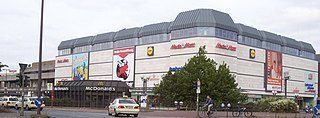
Hamburg-Altona is a railway station in Hamburg, Germany, situated to the west of the city's main station, in the district which bears its name.

The Berlin Stadtbahn is a major railway thoroughfare in the German capital Berlin, which runs through Berlin from east to west. It connects the eastern district of Friedrichshain with Charlottenburg in the west via 11 intermediate stations including Hauptbahnhof. The Berlin Stadtbahn is often also defined as the slightly longer route between Ostkreuz and Westkreuz, although this is not technically correct.

Berlin-Spandau station is a Deutsche Bahn station in the Berlin district of Spandau on the south-western edge of the old town of Spandau. The railway junction station is one of the 80 stations classified by Deutsche Bahn as a category 2 station. It has the longest train shed in Germany.

Barmbek is a railway station and transport hub in Hamburg, Germany, for the underground railway (U-Bahn) system and the suburban railway (S-Bahn) system. The station is located in the district of Barmbek-Nord, Germany. Barmbek-Nord is part of the borough of Hamburg-Nord.
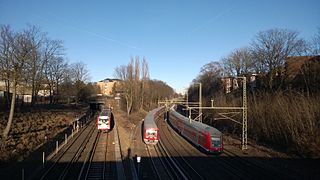
Rapid transit in Germany consists of four U-Bahn systems and fourteen S-Bahn systems. The U-Bahn commonly understood to stand for Untergrundbahn are conventional rapid transit systems that run mostly underground, while the S-Bahn or Stadtschnellbahn are commuter rail services, that may run underground in the city center and have metro-like characteristics in Munich, Hamburg and Berlin which they only have to a lesser extent in other cities. There are also over a dozen premetro or Stadtbahn systems that are rapid transit in the city center and light rail outside.

Ohlsdorf is a railway station in Hamburg, Germany, located at the junction of the Hamburg-Altona link line with the Alster Valley line and the Hamburg Airport line in Ohlsdorf, Hamburg near the Ohlsdorf Cemetery.
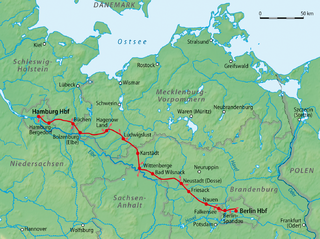
The Berlin–Hamburg Railway is a roughly 286 km (178 mi) long railway line for passenger, long-distance and goods trains. It was the first high-speed line upgraded in Germany to be capable of handling train speeds of over 200 km/h (120 mph).

The Berlin–Lehrte railway, known in German as the Lehrter Bahn, is an east–west line running from Berlin via Lehrte to Hanover. Its period as a separate railway extended from its opening in 1871 to the nationalisation of its owner, the Magdeburg-Halberstadt Railway Company on 1 July 1886. The company's Berlin station, the Lehrter Bahnhof was finally torn down in 1958.

The Berlin North-South main line, also called the North-South link (Nord-Süd-Verbindung) is an electrified railway line in Berlin which was opened in 2006. It is an important component of the “mushroom concept” (Pilzkonzept) adopted for long-distance and regional rail services through the city. Its core is an approximately 3.5 km (2.2 mi) long Tiergarten tunnel under the Tiergarten in Berlin. The tunnel section includes the underground level of Berlin Hauptbahnhof and the Potsdamer Platz regional station. The above-ground section of the line includes the Berlin Südkreuz station.
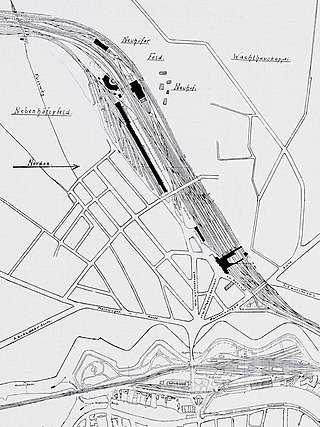
The Lübeck-Büchen Railway was a German railway company that built railway lines from Lübeck to Büchen and to Hamburg in the 19th century.

The Harburg S-Bahn line is a railway line in southern Hamburg, Germany. It starts at Hamburg Hauptbahnhof and runs via Harburg to Stade. It mostly runs parallel with the line to Hanover and the Lower Elbe line and is now part of the Hamburg S-Bahn lines S3 and S31.

The Hamburg freight rail bypass is a railway line in the German city of Hamburg. It runs from Hamburg-Eidelstedt via Hamburg-Rothenburgsort to Hamburg-Harburg and connects the long-distance railways approaching Hamburg, bypassing the link line and the railway junctions on the approaches to Hamburg-Altona station and Hamburg Hauptbahnhof. The line is mainly used for rail freight.
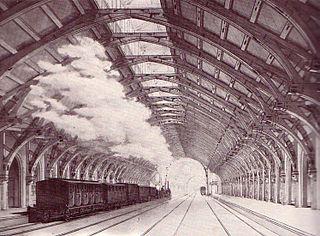
The Berliner Bahnhof in the German city of Hamburg was the western terminus of the Berlin-Hamburg railway opened in 1846. It was previously the site of the station built in 1844 to a design by Alexis de Chateauneuf for the Hamburg-Bergedorf Railway. Berliner Bahnhof was completed in 1857 and closed in 1903.


